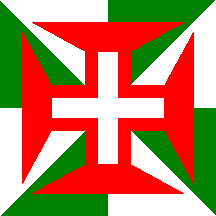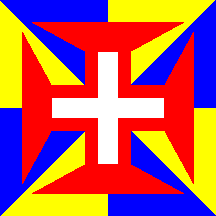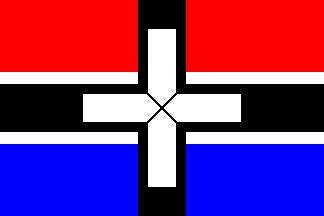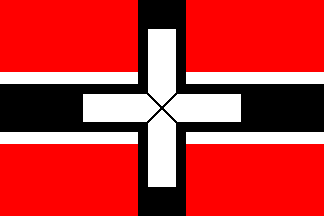
Last modified: 2006-09-30 by antónio martins
Keywords: christ knights’ order | ordem dos cavaleiros de cristo | bandé | fascé | cross: offset (black) | cross (white) | canton: cross | stripes: diagonal |
Links: FOTW homepage |
search |
disclaimer and copyright |
write us |
mirrors

Christ Order cross on green over silver gironny, from the map of
Jorge Reinel, 1540 [jre40].
The original depiction shows the cross whole with black instead of
silver, but this must be either an error or a tint alteration
(according to [qpt94]).
António Martins, 22 May 1997

Christ Order cross on silver over blue gironny, from the map of
Fernão Vaz Dourado, 1570 [fvd70]
(shown, i.a., in [qpt94]).
António Martins, 22 May 1997
This flag was one of the flags used by the Knights of the Order of Christ on their ships. It began to be used in the middle of the 17th century until circa 1789. The 1669/70 manuscript [xxx69] shows the flag with three horizontal stripes red - white - blue, with a black cross surmounted by a “shortened” (alesee) white one: this design comes from the 1647 work of Cleirac [cle47] which describes the flag:
Les Portugais portent facé de gueulles, d’argent et d’azur, chargé de la croix de sable ou noir, et derechef brisé sur icelle une autre croix pleniere d’argent, les quelles croix sont la devise des Chavaliers de l’Ordre du Christ qui ont grandement travaillé et travaillent incessamment aux navigations de Portugal vers l’Indie OrientaleIt is possible that Cleirac [cle47] confused "bandé" with "fascé". Also the Moutton manuscript (17th century) [mtn17], which also seems to derive from the Cleirac description [cle47], reports the same design. The text on this work says:
L’Ordre des Chevaliers de Jesus Christ… les chevaliers ont travaillé et travaillent encore aux navigations orientales et portent pour banniere le pavillon fascé de gueules, d’argent et d’azur, chargé d’une croix de sable et brisé sur icelle une autre croix d’argent.The same colors and the same crosses, however, appear differently on many 18th century flag charts, suggesting that Cleirac [cle47] and whose who copied him, bad interpreted the true flag design. The use of the black cross is very difficult to explain, being the cross of the Order not so. The flag was considered for a short period a sort of national flag, but it quickly disappeared from the charts. Most of this information come from L. Mouhlemann, “Les pavillons des nations maritimes au XVIIe siecle d’apres le manuscript de J. Moutton” on Recueil du IV congrès international de vexillologie, Torino, 1971 [mue71].
[bel56], as shown in the cover of
[sie63], calls it «Autre Pav. de
Portugal.» (1st of the flags partly visible on the 6th row from the
bottom): A flag with a black cross over hoist bends of white blue and red,
with in the canton maybe a white cross.
Peter Hans van den Muijzenberg, 05 Jan 2001
I never saw this flag in any portuguese source (neither this
one nor the other with a balck cross over all) and I
wouldn’t be too surprised if the whole thing about a black cross with
blue and red stripes turns out to be one big mystification after all. Two quite
different concurring designs casts serious doubts on the subject, that’s
for sure. And one can certainly wonder why the Christ Knights’ Order
would use a quite differnt flag for its ships
when its distinctive and widely known cross used on land (incl.
overseas, see the portolanoes with the usual order flag
sticked all across Asia, Africa and South America) and also painted on the
ships’ sails…
António Martins, 25 Dec 2001
Worth noting is that [sig12] describes the flag as follows (my translation):
Portugal from 1580-1640 was in a personal union with Spain and its ships flew the Spanisch flag. Where in grafical representations from this period Portuguese ships with flags are pictured the latter have the Burgundy cross. After Portugal aquired independence several flags came into use, which may have been already in use before and during the Spanisch rule. Fournier [fnr43] indicates that the Portuguese of the Indies flew a white flag with an astrolabium. Clairac [cle61] confirms this and further mentions, as a common flag, a black cross on a multiple blue-white-red diagonally striped field, where the upper quarter has a white cross.That means his source for the diagonal version is the same as our source for the horizontally striped version. Personally, I find the coincidence of a red-white-blue horizontally striped flag at that time a bit too much to swallow. Either it’s not a coincidence, or the flag was diagonally striped. But unless a comtemporary image of a ship flying this flag is found, I see the two separate crosses as a misinterpretation of the Cross of Christ.

This flag is shown in the Encyclopédie de Diderot et
D’Alembert (1768-1771).
Aitor Yuste, 28 Sep 2003
This flag described as Portuguese in the first edition of the
Encyclopaedia Britannica (1768-71).
The whole flag is covered in diagonal stripes running from upper hoist
to lower fly at 45 degrees. Six white stripes separated by six stripes
divided lengthways into red and blue. Thus the sequence from lower hoist
to upper fly is double width white, red, blue, double width white, red,
blue, etc..
On top of this background is a St. George’s cross of uncertain colour
(probably not red or blue or green or yellow; perhaps black?) In the
canton is another St. George’s cross probably white outlined in some way.
(The reproduction is in black and white with no key, so I’ve guessed the
colours by comparison with the shading used on known flags.)
David Prothero, 22 May 1997
A similar flag is illustrated in a flag chart reproduced in Whitney
Smith’s [smi75b] — see page 204.
The diagonal stripes appear to all be the same width, and the St George’s
Cross is indeed shown to be black. The flag is labled «Pav. de Portugal
particulier.» The chart appears to date from the early to mid 18th
century.
Nick Artimovitch, 22 May 1997
The same colors and the same crosses, however,
appear like this on many 18th century flag charts, suggesting that Cleirac
[cle47] and whose who copied him, bad
interpreted the true flag design.
Mario Fabretto, 25 May 1997
All sources I saw mentioning this flag show the non-orthogonal stripes
less wide and less vertical, resulting in differences in details.
I think this is true for Siegel [sig12],
Norie and Hobbs [noh71], a book by
the late D. W. Visser [vis95], and
and [bel56] as reproduced in part on the
cover of [sie63], where this is true as
well.
Peter Hans van den Muijzenberg, 23 Dec 2001
The image above (with strict 45° slants and constant
stripe width) comes from an article by Adolf Durán
[drn90f]. I suppose it is
an “idealized” design, based on several sketchy
(secondary) sources.
António Martins, 25 Dec 2001

The 1669/70 manuscript [xxx69] shows the flag with three horizontal stripes red - white - blue, with a black cross surmounted by a “shortened” (alesee) white one: this design comes from the 1647 work of Cleirac [cle47] which describes the flag:
Les Portugais portent facé de gueulles, d’argent et d’azur, chargé de la croix de sable ou noir, et derechef brisé sur icelle une autre croix pleniere d’argent, les quelles croix sont la devise des Chavaliers de l’Ordre du Christ qui ont grandement travaillé et travaillent incessamment aux navigations de Portugal vers l’Indie OrientaleMario Fabretto, 25 May 1997

The Sketchbook (No. 21) gives a somewhat different (incorrect) drawing
specified as «Dell’ ordine di Christo in Portogallo». There it is
a red flag with a black cross, the horizontal arms of which have a white
border, and superimposed on that the white couped cross.
This may well indicate that the artist drew from nature, because the
dark blue stripe at the bottom of a flying flag may, when lighted in a
particular way, have made the impression of a dark red.
Cleirac [cle47]
(page 64/66) also mentions this flag. The other sources do not include it.
Dave Martucci, 31 Jul 1997,
quoting [sie66]
Anything below this line was not added by the editor of this page.